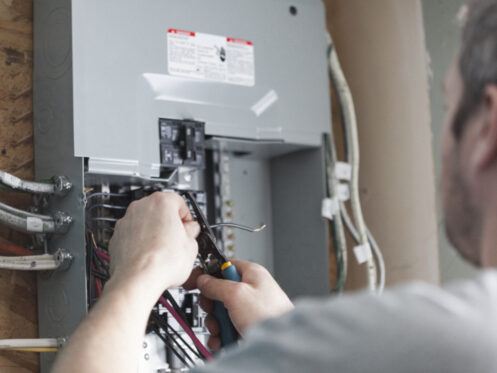Your home systems rely on a lot of electricity which makes it essential to know the basics of how your electrical panel works in your home. What do you do if your appliances stop working? Did a breaker trip, or is there something else going on? In this short guide, we will go over the basics of what electrical panels are and how they work.
What is an Electrical Panel?
An electrical panel, also known as a load center, service panel, breaker panel or panelboard, controls your home’s electricity. It distributes the electricity that your utility company provides throughout your house. It is usually gray, and if you open the front panel you will see multiple switches. These switches are circuits that are responsible for supplying electricity to certain areas within your home.
Your main electrical panel consists of several different parts:
- Main circuit breaker
- Other circuit breakers
- Hot bus bars
- Neutral bus bars
- Main bonding jumper
- Ground bus bar
If you live in an older home, you may have a fuse box instead of an electrical panel. These serve the same purpose but use fuses instead of circuit breakers. If you have additions, detached garages or a large kitchen you may also have a subpanel. These panels work with the electricity from the main panel and focus it in one area.
There are several sizes of electrical panels found in homes ranging from 100 amps to 400 amps. If you don’t use a lot of electrical appliances at once, 100 amps should be plenty; however, if you use a lot of appliances at once, you will need at least 150 amps. If your home is over 2000 square feet you will need 200 amps. Larger homes with heavy electricity usage, such as ones with workshops and outbuildings, will need 400 amps.
Service panels are made from steel to protect you from electrical current. It is dangerous to mess with anything in the electrical panel if you don’t know what you are doing. While some tasks are doable by homeowners, others require the assistance of a licensed electrician.
Installing Electrical Panels
You can install electrical panels virtually anywhere in or around your home. When your electrician installs a new electrical panel, they will follow several steps. First, they will ensure the electricity to the feed wires has been shut off by your power company. Then they will open all the metal knockouts on the box. These are spaces where the main service conduit and all the branch circuits will enter the box.
The conduit or cable connectors are then secured into the circuit breaker panel using knurled locknuts. The box is then mounted on a wall and secured with screws or anchors. Sometimes the correct fit of the electrical panel requires the wall to have a piece of plywood attached to it. The three main service wires are then brought in from outside your home. These main wires consist of two black hot wires and one white neutral wire. Your electrician will use fish tape to do this. The wires are attached to the tape and pulled through into the breaker panel.
The main grounding wire, which is a large bare copper wire, will then be fed into the panel and connected to the main grounding connection. The ground wire is connected to a grounding rod.
The main service neutral wire is then attached to the neutral bus bar. After that, the two black hot wires are connected to the main breaker. This is what connects the electrical panel to the electricity from your utility company. The main circuit breaker is attached to the hot bus bars. The end of the two black service wires will be stripped to connect them to the main breaker. Your electrician will make sure they don’t leave too much bare wire exposed since it can cause problems if they come in contact with other wires.
After this comes the installation of the individual branch circuits and breakers. The wires for the branch circuits are then pulled through a conduit and attached. If they are nonmetallic sheathed wires, then screws will hold them in place.
The green and bare copper wires for the branch circuits are then attached to the ground bus bar. After connecting these wires, their breakers are connected. To comply with code requirements and ensure safety, these breakers must have the proper voltage and amperage. Your highly trained electrician will know which ones to choose.
Installing the individual circuit breakers requires several steps. First, your electrician will attach the circuit’s neutral wire to the neutral bus bar. Then the red or black hot wire will be connected. After finishing these connections, any excess wire will be looped inside the panel along the edges.
After completing these tasks, your electrician will install the cover and request that your utility company restart the power. They will then test to make sure all the circuits are working. Labels are then put on the panel so you can know which circuit breaker corresponds to what area in your home.
Maintaining and Repairing Your Electrical Panels
If your system overloads, it will cause your circuit breaker to trip. You can check to see if one of the switches or levers is in the off position in your electrical panel. The main circuit breaker is often found at the top of the panel, though it can also be at the bottom or on one of the sides. If this trips, it means none of the other circuits can work; however, the electricity from your utility company is still on. This means there will still be a live current in the utility lines and terminals connected to the panel. That is why a trained electrician must handle any problems.
Flickering or dimming lights may indicate a problem with your electrical panel. Oftentimes this means it is not large enough to handle your electrical needs and will need upgrading.
If your electrical panel is emitting smoke, is hot to the touch or you see signs of corrosion, it is important to call your electrician to check it out. High humidity levels or leaks in the wall can lead to corrosion. In either case, you’ll need to replace your electrical panel if it’s covered in rust. If the location is too wet or humid, it might also need to be moved.
Routine maintenance for your electrical panel is essential. This helps avoid more serious issues like electrocution and fires. Our electricians will come inspect your panel and make sure everything is working properly. When an electrical panel is properly maintained, it can last between 25-40 years.
At John Henry's Plumbing, Heating, Air, and Electrical, we strive to provide top-notch service to all our customers. We have been in business for over 20 years. Our highly trained electricians, plumbers and HVAC technicians can help you with all your home service needs. We believe in offering affordable service that is high quality. You can rely on us to complete any necessary maintenance or repairs, as well as new panel installation, safely and effectively.
Contact John Henry's Plumbing, Heating, Air, and Electrical for more information about our electrical and other services in Lincoln today!

